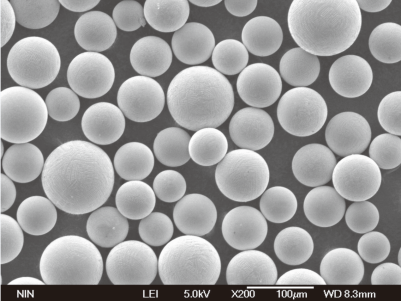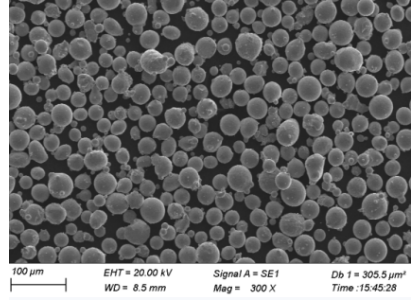개요
원자화 후 처리 은 항공우주부터 의료기기에 이르기까지 다양한 산업의 제조 공정에서 매우 중요한 역할을 합니다. 이 공정은 금속 분말의 특성을 향상시켜 특정 용도에 더 적합하게 만듭니다. 일반적으로 어닐링, 체질 및 표면 수정과 같은 공정을 통해 입자 크기 분포, 형태 및 화학 성분을 개선합니다.
원자화 후 치료란 무엇인가요?
원자화 후 처리란 원자화를 통해 금속 분말을 생산한 후 금속 분말에 적용되는 다양한 방법을 말합니다. 원자화는 용융 금속을 미세한 물방울로 분해한 다음 분말 입자로 응고시키는 공정입니다. 원자화 후 처리는 분말의 특성을 향상시키고 일관성을 보장하며 최종 사용 응용 분야에서 성능을 개선하는 데 필수적입니다.

금속 분말의 종류와 성분
금속 분말은 다양한 종류가 있으며, 각 분말은 특정 용도에 맞는 고유한 구성과 특성을 가지고 있습니다. 다음은 가장 일반적으로 사용되는 금속 분말과 그 성분입니다:
| 금속 분말 | 구성 | 속성 |
|---|---|---|
| 스테인리스 스틸 316L | Fe, Cr, Ni, Mo | 내식성, 높은 인장 강도 |
| 티타늄 Ti6Al4V | Ti, Al, V | 높은 중량 대비 강도, 내식성 |
| 알루미늄 6061 | Al, Mg, Si | 가볍고 우수한 기계적 특성 |
| 코발트-크롬 합금 | Co, Cr, Mo | 높은 내마모성, 우수한 생체 적합성 |
| 니켈 합금 625 | Ni, Cr, Mo, Nb | 고강도, 우수한 내식성 |
| 마레이징 스틸 18Ni300 | Fe, Ni, Co, Mo | 높은 강도, 우수한 인성 |
| 구리 합금 C18150 | Cu, Cr, Zr | 높은 전도성, 우수한 내마모성 |
| 텅스텐 카바이드 | WC, Co | 극한의 경도, 내마모성 |
| 인코넬 718 | Ni, Cr, Fe, Nb, Mo | 고강도, 우수한 내산화성 |
| 청동 합금 CuSn12 | Cu, Sn | 우수한 내식성, 우수한 가공성 |
원자화 후 처리용 분말의 특성
원자화 후 처리는 금속 분말의 다양한 특성을 향상시키기 위해 고안되었습니다. 다음은 몇 가지 주요 특성을 살펴봅니다:
| 특징 | 설명 |
|---|---|
| 입자 크기 분포 | 균일성 보장, 유동성 및 포장 밀도에 영향을 미침 |
| 형태학 | 흐름과 포장에 영향을 미치는 구형 또는 불규칙한 모양 |
| 표면적 | 반응성 및 소결 동작에 영향을 미칩니다. |
| 순도 | 높은 순도 수준으로 오염 위험 감소 |
| 흐름성 | 취급 및 처리의 용이성에 영향을 미칩니다. |
| 겉보기 밀도 | 포장 및 소결 효율에 영향 |
| 산화 수준 | 산화가 적어 고온 애플리케이션에서 성능 향상 |
파우더의 응용 분야 원자화 후 처리
원자화 후 금속 분말의 향상된 특성으로 인해 다양한 응용 분야에 적합합니다:
| 애플리케이션 | 설명 |
|---|---|
| 항공우주 | 고강도 경량 부품 |
| 자동차 | 엔진 부품, 변속기 부품 |
| 의료 기기 | 임플란트, 수술 기구 |
| 에너지 분야 | 터빈 블레이드, 연료 전지 |
| 전자 제품 | 전도성 잉크, 열 관리 |
| 툴링 | 절삭 공구, 금형 |
| 적층 제조(3D 프린팅) | 사용자 지정, 복잡한 형상, 프로토타이핑 |






사양, 크기, 등급 및 표준
원자화 후 처리를 위한 금속 분말을 선택할 때는 사양, 크기, 등급 및 표준을 고려하는 것이 중요합니다. 자세한 표를 참고하세요:
| 파우더 유형 | 크기 범위(µm) | 등급 | 표준 |
|---|---|---|---|
| 스테인리스 스틸 316L | 15-45, 45-105 | AISI 316L | ASTM A276, AMS 5653 |
| 티타늄 Ti6Al4V | 15-45, 45-90 | 5학년 | ASTM B348, AMS 4928 |
| 알루미늄 6061 | 20-63, 63-125 | AA 6061 | ASTM B209, AMS 4027 |
| 코발트-크롬 합금 | 10-45, 45-90 | ASTM F75 | ISO 5832-4 |
| 니켈 합금 625 | 15-53, 53-150 | UNS N06625 | ASTM B446, AMS 5666 |
| 마레이징 스틸 18Ni300 | 10-45, 45-105 | 300등급 | AMS 6514, ASTM A538 |
| 구리 합금 C18150 | 20-53, 53-150 | UNS C18150 | ASTM B606, RWMA 클래스 2 |
| 텅스텐 카바이드 | 5-15, 15-45 | ISO 9001 인증 | ISO 9001, ASTM B777 |
| 인코넬 718 | 15-45, 45-105 | UNS N07718 | ASTM B637, AMS 5662 |
| 청동 합금 CuSn12 | 20-63, 63-150 | UNS C90700 | ASTM B505, AMS 4880 |
공급업체 및 가격 세부 정보
고품질의 금속 분말을 얻으려면 올바른 공급업체를 선택하는 것이 중요합니다. 몇 가지 공급업체와 가격 세부 정보를 살펴보세요:
| 공급업체 | 위치 | 금속 분말 | 가격(USD/kg) |
|---|---|---|---|
| 호가나스 AB | 스웨덴 | 스테인리스 스틸 316L | $50 – $70 |
| LPW 기술 | UK | 티타늄 Ti6Al4V | $300 – $400 |
| 카펜터 기술 | 미국 | 알루미늄 6061 | $25 – $40 |
| Arcam AB(GE 애디티브) | 스웨덴 | 코발트-크롬 합금 | $250 – $350 |
| 샌드빅 | 스웨덴 | 니켈 합금 625 | $100 – $150 |
| GKN 회가나에스 | 미국 | 마레이징 스틸 18Ni300 | $150 – $200 |
| 아메텍 특수 금속 | 미국 | 구리 합금 C18150 | $30 – $50 |
| 케나메탈 | 미국 | 텅스텐 카바이드 | $70 – $90 |
| 금속 분말 및 공정 | 미국 | 인코넬 718 | $200 – $250 |
| 금속 분말 제조 | UK | 청동 합금 CuSn12 | $20 – $35 |
원자화 후 치료를 위한 파우더의 장단점
모든 금속 파우더에는 고유한 장점과 한계가 있습니다. 비교해보면 다음과 같습니다:
| 금속 분말 | 장점 | 제한 사항 |
|---|---|---|
| 스테인리스 스틸 316L | 내식성, 고강도 | 다른 강재에 비해 높은 비용 |
| 티타늄 Ti6Al4V | 경량, 고강도 | 비싸고 처리하기 어려운 데이터 |
| 알루미늄 6061 | 가볍고 우수한 기계적 특성 | 강철에 비해 낮은 강도 |
| 코발트-크롬 합금 | 높은 내마모성, 생체 적합성 | 비싸고 기계 가공이 어려운 제품 |
| 니켈 합금 625 | 우수한 내식성, 고강도 | 고가, 고밀도 |
| 마레이징 스틸 18Ni300 | 높은 강도, 우수한 인성 | 비싸고 열처리가 필요함 |
| 구리 합금 C18150 | 높은 전도성, 내마모성 | 산화되기 쉽고 강철보다 강도가 낮음 |
| 텅스텐 카바이드 | 매우 단단하고 내마모성이 뛰어남 | 깨지기 쉽고, 비싸다 |
| 인코넬 718 | 고강도, 우수한 내산화성 | 비싸고 기계 가공이 어려운 제품 |
| 청동 합금 CuSn12 | 우수한 내식성, 기계 가공 가능 | 다른 합금에 비해 낮은 강도 |
분무 후 처리를 위한 파우더의 장점
원자화 후 처리는 금속 분말의 품질과 성능을 개선하는 다양한 이점을 제공합니다. 이점에 대해 자세히 살펴보세요:
향상된 입자 크기 분포
체질 및 분류와 같은 원자화 후 처리는 적층 제조 및 분말 야금과 같은 응용 분야에서 일관된 성능을 위해 중요한 균일한 입자 크기 분포를 달성하는 데 도움이 됩니다.
향상된 형태학
어닐링 및 열처리와 같은 처리를 통해 분말 입자의 형태를 개선하여 더 구형으로 만들 수 있습니다. 구형 입자는 더 잘 흐르고, 더 효율적으로 포장되며, 더 높은 품질의 완제품을 생산할 수 있습니다.
오염 감소
오염을 최소화한 고순도 분말은 의료 기기 및 항공우주 부품과 같은 응용 분야에 필수적입니다. 원자화 후 처리는 분말이 엄격한 순도 요건을 충족하도록 보장합니다.
최적화된 유동성
3D 프린팅 및 금속 사출 성형과 같은 공정에서는 우수한 유동성이 매우 중요합니다.
원자화 후 처리는 분말의 흐름 특성을 향상시켜 원활하고 안정적인 처리를 보장합니다.
제어된 산화 수준
고온 응용 분야에서는 금속 분말의 산화 수준을 제어하는 것이 필수적입니다. 원자화 후 처리는 산화를 줄여 최종 제품의 성능과 수명을 개선하는 데 도움이 됩니다.
분말의 사양, 크기, 등급 및 표준은 다음과 같습니다. 원자화 후 처리
올바른 금속 분말을 선택하려면 다양한 사양, 크기, 등급 및 표준을 고려해야 합니다. 자세한 분석은 다음과 같습니다:
| 금속 분말 | 크기 범위(µm) | 등급 | 표준 |
|---|---|---|---|
| 스테인리스 스틸 316L | 15-45, 45-105 | AISI 316L | ASTM A276, AMS 5653 |
| 티타늄 Ti6Al4V | 15-45, 45-90 | 5학년 | ASTM B348, AMS 4928 |
| 알루미늄 6061 | 20-63, 63-125 | AA 6061 | ASTM B209, AMS 4027 |
| 코발트-크롬 합금 | 10-45, 45-90 | ASTM F75 | ISO 5832-4 |
| 니켈 합금 625 | 15-53, 53-150 | UNS N06625 | ASTM B446, AMS 5666 |
| 마레이징 스틸 18Ni300 | 10-45, 45-105 | 300등급 | AMS 6514, ASTM A538 |
| 구리 합금 C18150 | 20-53, 53-150 | UNS C18150 | ASTM B606, RWMA 클래스 2 |
| 텅스텐 카바이드 | 5-15, 15-45 | ISO 9001 인증 | ISO 9001, ASTM B777 |
| 인코넬 718 | 15-45, 45-105 | UNS N07718 | ASTM B637, AMS 5662 |
| 청동 합금 CuSn12 | 20-63, 63-150 | UNS C90700 | ASTM B505, AMS 4880 |
비교 분석: 원자화 후 처리를 위한 분말 유형
다양한 금속 분말을 자세히 비교해 보겠습니다:
스테인리스 스틸 316L 대 티타늄 Ti6Al4V
스테인리스 스틸 316L 는 내식성과 강도로 잘 알려져 있습니다. 하지만 티타늄 Ti6Al4V 는 더 가볍고 무게 대비 강도가 높아 무게가 중요한 항공우주 및 의료 분야에 이상적입니다.
알루미늄 6061 대 코발트-크롬 합금
알루미늄 6061 는 우수한 기계적 특성을 제공하고 가볍지만, 내마모성과 생체 적합성에서는 코발트-크롬 합금의료용 임플란트 및 치과용 애플리케이션에 선호됩니다.
니켈 합금 625 대 마레이징 스틸 18Ni300
니켈 합금 625 는 내산화성이 뛰어나 고온 및 부식성 환경에 적합합니다. 반면에 마레이징 스틸 18Ni300 는 뛰어난 강도와 인성을 제공하여 툴링 및 구조물 제작에 적합합니다.
구리 합금 C18150 대 텅스텐 카바이드
구리 합금 C18150 는 전기 전도성과 내마모성이 뛰어나 전기 접점에 사용하기에 적합합니다. 반대로 텅스텐 카바이드 는 경도와 내마모성이 뛰어나 절삭 공구 및 마모 부품에 이상적입니다.
인코넬 718 대 청동 합금 CuSn12
인코넬 718 는 강도가 높고 극한 환경에서 내산화성이 우수하여 선호됩니다. 청동 합금 CuSn12는 가공성과 내식성이 뛰어나 베어링과 부싱에 주로 사용됩니다.
전문가 의견 및 연구
연구와 전문가 의견에 따르면 금속 분말의 원하는 특성을 달성하는 데 있어 원자화 후 처리의 중요성이 강조되고 있습니다. 연구에 따르면 최적화된 입자 크기 분포와 형태가 적층 제조 및 기타 응용 분야에서 분말의 성능에 큰 영향을 미치는 것으로 나타났습니다.
예를 들어, 미국 재료시험학회(ASTM)의 연구에서는 3D 프린팅 부품의 다공성을 줄이고 기계적 특성을 향상시키는 데 있어 원자화 후 처리의 역할을 강조합니다. 마찬가지로 금속 분말 산업 연맹(MPIF)의 전문가들은 항공 우주 및 의료 기기와 같은 중요한 응용 분야에서 고순도 분말의 필요성을 강조합니다.

자주 묻는 질문
| 질문 | 답변 |
|---|---|
| 원자화 후 치료란 무엇인가요? | 원자화 후 처리란 원자화 후 금속 분말의 특성을 향상시키기 위해 어닐링, 체질 및 표면 개질과 같은 공정을 말합니다. |
| 입자 크기 분포가 중요한 이유는 무엇인가요? | 균일한 입자 크기 분포는 3D 프린팅 및 분말 야금과 같은 다양한 응용 분야에서 일관된 유동성, 포장 밀도 및 전반적인 성능을 보장합니다. |
| 구형 파우더 형태는 어떤 이점이 있나요? | 구형 분말은 불규칙한 모양의 분말에 비해 더 잘 흐르고, 더 효율적으로 포장되며, 더 높은 품질의 완제품을 생산할 수 있습니다. |
| 원자화 후 처리로 어떻게 오염을 줄일 수 있나요? | 체질 및 열처리와 같은 처리는 불순물과 오염 물질을 제거하여 중요한 응용 분야에 적합한 고순도 분말을 보장합니다. |
| 항공우주 분야에 가장 적합한 금속 분말은 무엇인가요? | 티타늄 Ti6Al4V는 무게 대비 강도가 높고 내식성이 뛰어나 항공우주 부품에 이상적인 소재입니다. |
| 니켈 합금 625 사용의 주요 장점은 무엇인가요? | 니켈 합금 625는 특히 고온 및 부식성 환경에서 높은 강도와 우수한 내식성을 제공합니다. |
| 금속 분말의 유동성은 어떻게 향상되나요? | 체질 및 어닐링과 같은 원자화 후 처리는 분말의 유동 특성을 개선하여 취급 및 가공을 용이하게 합니다. |
| 금속 분말에서 산화 수준의 중요성은 무엇인가요? | 낮은 산화 수준은 최종 제품의 성능과 수명을 향상시키기 때문에 고온 애플리케이션에 매우 중요합니다. |
| 원자화 후 처리로 기계적 특성을 개선할 수 있나요? | 예, 어닐링 및 열처리와 같은 처리를 통해 금속 분말의 기계적 특성을 향상시켜 특정 용도에 더 적합하게 만들 수 있습니다. |
| 의료용 임플란트에 가장 적합한 금속 분말은 무엇인가요? | 코발트-크롬 합금은 내마모성이 높고 생체 적합성이 뛰어나 의료용 임플란트에 일반적으로 사용됩니다. |

